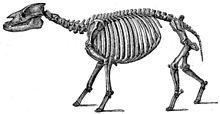Palaeotheriidae
This article needs additional citations for verification. (July 2023) |
| Palaeotheriidae | |
|---|---|

| |
| Palaeotherium magnum skeleton | |
| Scientific classification | |
| Domain: | Eukaryota |
| Kingdom: | Animalia |
| Phylum: | Chordata |
| Class: | Mammalia |
| Order: | Perissodactyla |
| Suborder: | Hippomorpha
|
| Family: | †Palaeotheriidae Bonaparte, 1850 |
| Genera | |
| Synonyms | |
|
Pachynolophidae Pavlow, 1888 | |
Palaeotheriidae is an
Morphology


Palaeothere sizes ranged from 20 to 75 cm (8 to 30 in) at the shoulder, and weighed an estimated 10–30 kg (20–70 lb).
Taxonomy
Paleotheriidae is generally divided into the subfamilies Palaeotheriinae and ‘Pachynolophinae'. The two groups are distinguished by the morphology of their upper molars, with mesostyles being at least moderately developed in those Palaeotheriinae, but generally weakly developed or absent in those of 'Pachylophinae'. 'Pachylophinae' is controversial with regards to its definition and phylogenetic placement.
Ecology
Early members of the family are suggested to have been frugivores, with later, larger members suggested to be browsers.[6]
Extinction
Evidence suggests that palaeotheriids went extinct in
Fossil distribution
- Creechbarrow Hill Site, Dorset, England
- Geiseltal, Mittelkohle, Zone III, Saxony-Anhalt, Germany
- Egerkingen, Alpha & Beta fissures, Baselland, Switzerland
- La Debruge, Provence-Alpes-Côte d'Azur Region, France
- The Caucasus Mountains in Georgia
See also
References
- S2CID 258663753.
- .
- ^ ISSN 0031-0239.
- ISSN 0272-4634.
- ^ S. Legendre. 1988. Les communautes de mammiferes du Paleogene (Eocene superieur et Oligocene) d'Europe occidentale: structure, milieux et evolution. Ph.D. thesis, Universite des Sciences et Techniques du Languedoc, Montpellier, France. 2 volumes. 1-265
- ^ ISSN 1867-1594.
- ^ ISSN 0272-4634.
